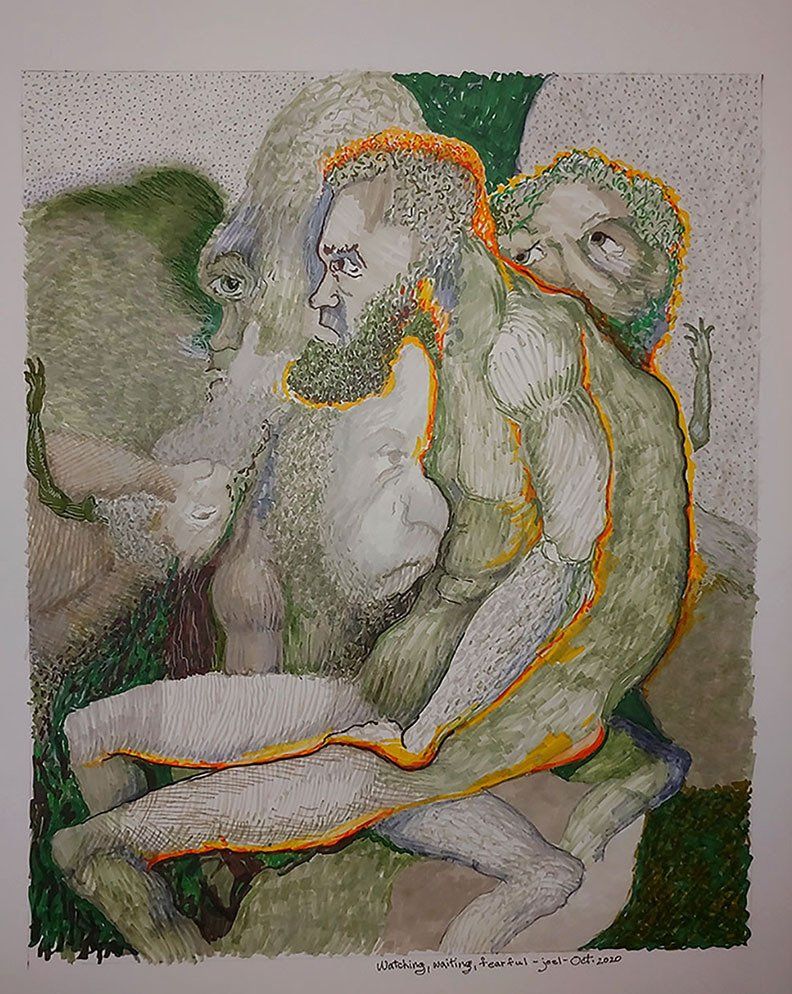Being with friends is one way to beat the blues. Music is another. Together, they are a dynamic combination.

What to do with the aging blues? Life throws a lot of bad things at us at times. Aging seems to intensify it. Sometimes it seems that here comes the blues should be our daily anthem. But letting the blues settle in and dominate our thoughts makes them worse.
How to shake them? Finding ways to be with friends is a good start! Doing enjoyable activities together is even better. Dion comes to mind for doing this in grand fashion. I realized this after reading Alan Paul’s article about Dion releasing a new album Blues with Friends at age 80. 1 Playing music, listening, and singing with friends is a sure-fire way to ditch the blues. And it has worked well for Dion. I was originally surprised to find a 50’s rock star who was not only still alive but also still writing and recording music. Listening to his new album and fully enjoying the songs with heavy guitar and drum rhythms, I gave it 5 stars. It was a great way to shake the blues.
Dion is still a creative force in the 2020’s. How has he done this? His life story is revealing. Dion’s professional career took off in 1959 with his first hit song I Wonder Why. Other classic rock hits like The Wanderer and Runaround Sue quickly followed. Sixty years later, his friends playing along and singing on Blues with Friends include musical greats in their own right: Bruce Springsteen, Paul Simon, and Van Morrison. I love Bob Dylan’s comment included on the album cover, “You have to be careful with the blues. They’re strong with lust. Dion knows how to sing, and he knows just the right way to craft these blues songs.”
Maintaining a lust for life is part of the secret for staying creative in aging. Dion like most of us has experienced deep dark periods while going through bad times. In 1959 along with his first big hit record, he was touring with Buddy Holly. However, he opted out of the plane flight immortalized in the song The Day the Music Died. The crash that killed Holly, rock musician Ritchie Valens, and disc-jockey J.P. Richardson. Dion took the tour bus instead thinking that the plane ticket was too expensive. In his grief from losing his friends (and likely survivor’s guilt), Dion turned to heroin – and became addicted.
By 1965 at age 25, Dion’s career was tanking. Drugs and alcohol were taking their toll. He was coming close to joining the many musicians in the “27 Club” like Jimi Hendrix, Janis Joplin and Jim Morrison who died around that age. In 1967, his close friend musician Frankie Lymon, with whom he would often get high with on heron, died from an overdose just months under 26 years of age. 2 Shocked, knowing his life was a mess, and that he was close to dying from addiction like Lymon, Dion reconnected to his spiritual roots. As often happens in life and death situations, he prayed to God vowing to change if he received Divine assistance. As sometimes happens, Dion kept his part of the bargain, turning his life around and staying off drugs and alcohol.
Six months later, he wrote and released Abraham, Martin and John, a moving tribute to Abraham Lincoln, Martin Luther King, and John Kennedy who were killed in turbulent times. The sober, drug-free decades that followed have been filled with songwriting, singing, and recording gospel and blues music. Dion was inducted into the Rock and Roll Hall of Fame in 1989. Music critics who panned his early work as trivia now recognize its importance in influencing many other musicians like Bruce Springsteen. His superb craftsmanship in creating gospel and blues music has led to receiving numerous awards and Grammy nominations.
Keeping The Blues Healthy
Maintaining creativity and a passionate love for living into your 80’s is a testament to successfully dealing with the blues. Dion’s story is powerful and provides important insights that transcend the individual. Music is a universal antidote to the blues. Sadness is an emotion and mood. Listening to music activates the reward system of the brain increasing feelings of pleasure, reducing sadness. The natural neurochemical dopamine drives the process, being released by nerve cells in brain areas stimulating positive expectations for enjoyment and pleasure from hearing good music. Good being in the mind of the hearer! Depending on the music and the person, the experience can range from peaceful serenity to ecstatic arousal.
As a neuroscientist, I appreciate well-crafted studies sorting out what is going on in the brain that explains human behavior. Studies conducted Laura Ferreri and her colleagues on the role of dopamine in enjoying and remembering music are good examples. Working with healthy volunteers listening to music, the investigators measured their responses to raising dopamine levels in their brain using the drug levodopa. Then, they lowered brain dopamine levels with the drug risperidone.3 After receiving one or the other drug, the volunteers rated their level of pleasure with each musical experience. In addition, their level of arousal was measured by skin electrical activity (a reliable indicator used in many studies). A third measure was the monetary value the volunteer placed on the musical piece if they were to purchase it. All three measures were significantly increased when brain dopamine levels were elevated by levodopa and decreased when dopamine levels were lowered with risperidone.
The positive reward response to music not only increased joy, but also improved memory functions.4 The beneficial effects of music on the brain extend beyond activating the brain's reward system. One of the greatest boosts in shaking the Blues comes from increased levels of the natural hormone oxytocin that promotes socializing and working cooperatively with others.5 Singing together in choirs, singing in get-togethers of all sorts from religious to political meetings, and in parties are integral to the human experience. All are events promoting bonding and prosocial togetherness. Add physical activity into the mix - dancing, exercising, playing musical instruments – and you have a powerful combination for shedding the blues in all stages of life, including the aging blues.
_____________________________________________________________________
The Author:
Don Gash is an emeritus professor of Neuroscience (PhD) in the College of Medicine and Lewis Honors College at the University of Kentucky. His expertise is indrug development for diseases of aging, especially those effecting the brain. Over fifteen years ago, he recognized that aging posed serious threats to health and wellbeing – and had many features of being a disease. Dr. Gash felt that his experience in developing therapies for neurological diseases could be used to better understand normal aging processes and ways to promote successful aging. Ways that activate natural healing processes in the brain and body to effectively restore true wellbeing. Lifestyles and practices that do not replace good medical care when needed but make it work better. The advice given is evidence-based on published studies, including his, and from his years of personally testing many programs and exercises to identify those which effectively cultivate and enable Aging Successfully.
Sources
PubMed identification numbers (PMID) are given for peer-reviewed scientific reports in mainstream
science journals. The scientific papers are available online through PubMed on www.nlm.nih.gov.
1. Paul A. (12June 2020) Dion Still Sings of America. Wall Street Journal
2. Purcell A. (14Dec 2006) ‘I saw the devil himself’ The Guardian
3. Ferreri L. et al. (2019) Dopamine modulates the reward experiences elicited by music. PNAS
116:3793-3798. PMID: 30670642
4. Ferreri L. (2021) Dopamine modulations of reward-driven music memory consolidation. Ann N Y
Acad Sci. 1502: 85-98. PMID: 34247392
5. Harvey A. (2020) Links between the neurobiology of oxytocin and human musicality. Front. Hum.
Neurosci. 14:350. PMID: 33005139
All Rights Reserved | Aging Successfully







